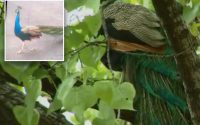Downed Chinese balloon aimed for Hawaii, blown off course
The Chinese spy balloon that was shot down with a missile off South Carolina originally had a trajectory that would have taken it over Guam and Hawaii but was blown off course, a government official has revealed.
The balloon, which Washington accuses Beijing of using for espionage and China says was a civilian weather research airship, was derailed from heading to the islands by prevailing winds, a US official speaking on condition of anonymity told Reuters.
The balloon drifted across Alaska’s Aleutian Islands, then Canada and the central US before it was downed by a missile fired from an F-22 fighter jet on Feb. 4.
The US military said Monday it had recovered critical electronics from the balloon as well as large sections of the vessel itself.
The incident has further strained US-China relations and prompted Secretary of State Antony Blinken to cancel a planned visit to Beijing last week.


US military and intelligence agencies tracked the balloon from when it lifted off from Hainan Island near China’s south coast, the Washington Post reported Tuesday.
During a regular briefing Thursday, Chinese Foreign Ministry spokesperson Wang Wenbin did not answer a question about whether the balloon was set to fly over Guam and Hawaii before it was blown off course by prevailing winds, instead repeating the Chinese position that Washington should not “overreact.”
During the previous day’s briefing, Wang threatened retaliation against US entities for allegedly undermining China’s sovereignty.

“The US has abused force, overreacted, escalated the situation, and used this as a pretext to illegally sanction Chinese companies and institutions,” Wang said.
“China is firmly opposed to this and will take countermeasures against relevant US entities that undermine China’s sovereignty and security in accordance with the law.”
China will “resolutely safeguard national sovereignty and its legitimate rights and interests,” Wang added.

On Thursday, China imposed trade and investment sanctions on Lockheed Martin and Raytheon for supplying weapons to Taiwan, which Beijing claims as part of its dominion.
It was unclear whether the sanctions targeting US military contractors were related to the fallout from the balloon incident.
While China denies the balloon was a military asset, it has yet to say what government department or company was responsible for its operation.
After initially expressing regret over the balloon’s unsanctioned entry into US airspace, China has escalated its rhetoric against Washington, claiming earlier this week that the US had flown more than 10 high-altitude balloons in its airspace over the past year.


White House national security spokesman John Kirby dismissed China’s accusation as “absolutely not true.”
With Post wires





